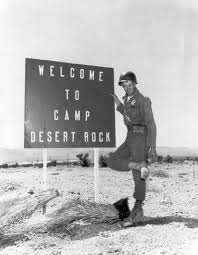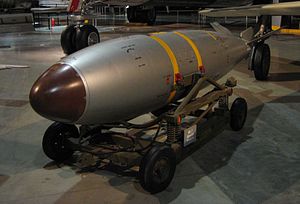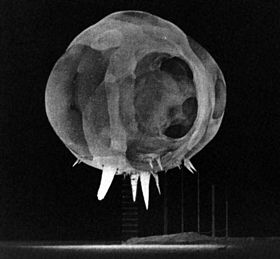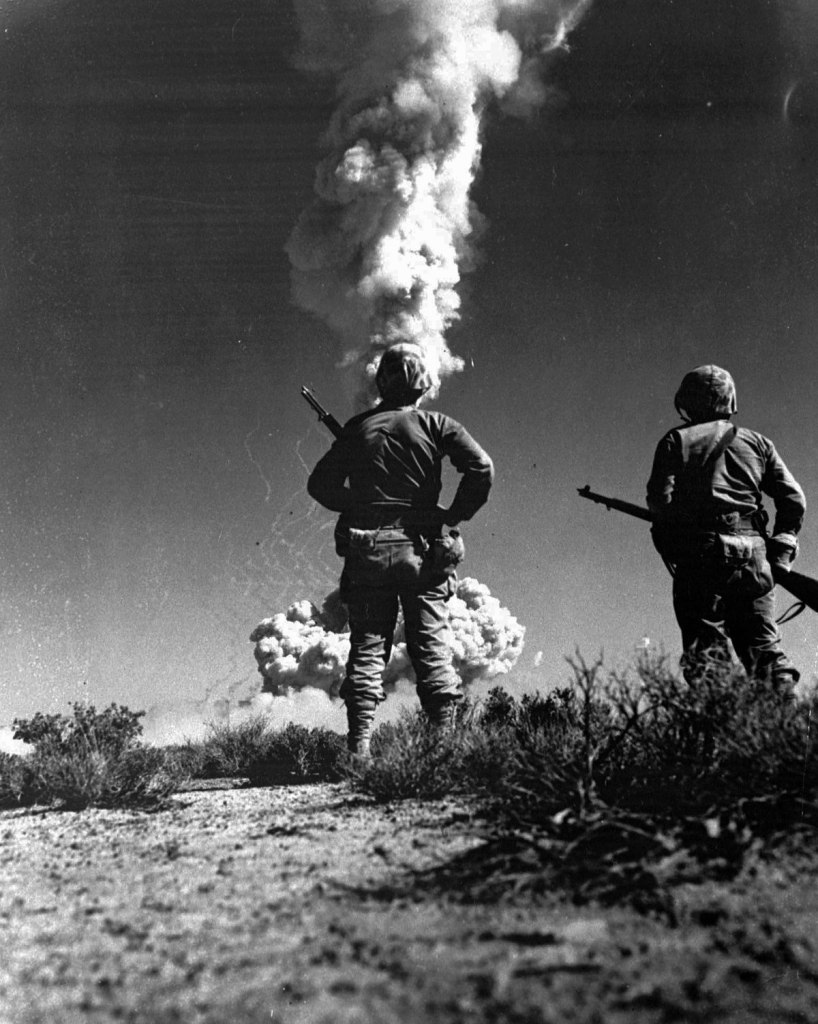“They put us out in the middle of nowhere.” Sheriff Toby Madrid had his hands wrapped around a cup of black coffee, and his feet up on the desk. The casual laid back attitude belied the tension in his jaw. He also wasn’t looking at JR or me as he spoke, but at the wall. It was almost as if he looked at us, he’d never finish talking about what he had to say.
“They told us we were there to be part of an atomic bomb test.”
 The test the Sheriff was talking about was part of what we know today as the Desert Rock Exercises. My research seems to single him out for what was called Desert Rock IV, or a series of tests called Operation Tumbler-Snapper.
The test the Sheriff was talking about was part of what we know today as the Desert Rock Exercises. My research seems to single him out for what was called Desert Rock IV, or a series of tests called Operation Tumbler-Snapper.
From 1951 to 1957, at the Nevada Proving Grounds, a small camp called Camp Desert Rock was built. Its job was to provide for billets and a staging area as the US Military conducted a variety of tests using military personnel and the bomb. The idea was to gauge the effectiveness of combat troops where a nuclear weapon had been used to soften up enemy positions.
“We were out at the camp for a few days before the actual test. They had us go out and dig trenches. In some cases, sandbagged defensive positions were built. The positions were deep enough for us squat or stand in.

“I remember as we were digging, trucks were going by carrying tanks or jeeps. Some vehicles were towing artillery pieces out there. Some of our guys went out with them and came back saying that dummies in uniforms had been included, some standing, some lying down.”
From my research, the Sheriff, who was a Marine at the time, was part of Shot DOG nuclear test, and the test was conducted on May 1, 1952. The weapon was most likely a Mark 7 bomb.
The aircraft used in the drops were the Boeing B-50 and the North American B-45. I don’t know and wasn’t able to find which did the drop here. I looked at the video of the drop, but couldn’t tell.
“Our trenches were about four miles from the blast,” the Sheriff said. “The day of the test, we got up, had breakfast, then they trucked us out to the site. We got into our trenches and were instructed to crouch below the rim of the trench, our faces down, and eyes closed when the blast happened. They’d let us know beforehand, and we’d see and hear the bomber coming in.
“About 8:30 or so, we heard aircraft high up, and then came the warning of the drop. We climbed into the trench and crouched down like they instructed us. I had my head down and eyes closed.
“Suddenly, there was light. Even with eyes closed and head down, I saw it.”

What the Sheriff had witnessed was an detonation of a 19 kiloton bomb. It exploded about a thousand meters above the ground.
“The light faded, but as it faded, I heard painful thunder. Then a sudden wind came up. Dirt and sand blew over and into the trench, the wind rocking me back against the wall of the trench. Then the wind rushed back from the other direction, shoving me into the front of the trench.
“Seconds later, when the order to leave our trenches came, we climbed out. Movies can’t describe the mushroom a bomb generates. It cascaded up into the sky, an angry white and black cloud boiling up like something from hell. There’s no way you can imagine it. Even if you see it, you can’t believe it’s real.
“They told us to start walking forward, so we did. Along the way we passed some of the things set up the day before. At one location I remember seeing a Sherman tank.

“The blast had knocked it over as if a giant had swatted it. Here and there were some of the dummies. Some had burnt up almost entirely, others were smoldering. We got to about three quarters of a mile from where the bomb had exploded. They stopped and turned us around. I remember hearing someone say ‘It’s too hot to go further.’ I learned later that they meant it was too radioactive.
“They marched us out of there to a place where we were swept and hosed off. I was surprised at the dust that came off me and the rest of my platoon. I threw that uniform away.

“We were kept out there for a few days, and people came around asking how we felt. I felt fine and said so. A few days later, they sent buses out and they took us back to base.”
That’s the only time I ever recall the Sheriff talking about it. My buddy JR confirmed that in all the years he’d been with his father, he’d rarely heard him speak about the day the bomb exploded.
While the Desert Rock Exercises are public knowledge, it’s also something a lot of people don’t stop and think about. I hope the Sheriff’s story brought attention to events that still impact us to this day.

Many of us might recall our parents telling us not to eat the fresh fallen snow because of fallout from the bomb. It kind of shows the scare the tests put into just the regular people.
After I wrote the original story, I received several comments that people they knew (in some cases – parents) lived downwind of the blast, and that’s where the fallout came down. Many died because of cancers. Most never knew the cause until well after the fact, or that fallout had come down on their them or their homes.
An incident that has never been proven conclusively, but may well be linked to the Desert Rock tests was the filming of the John Wayne movie, The Conqueror. Apparently the site they filmed at was where a vast amount of fallout came down. Odd part was the studio asked the government if the site was free of dangers since it wasn’t far from the test sites. They were assured that it was well outside the fallout zone.
It wasn’t. The area they filmed in had fallout come down on it more than once.
I recall reading an interview with John Wayne who said there wasn’t a lot to do after they finished shooting for the day, and so they played baseball. He recalled watching Susan Heyward running the bases in her bare feet and her feet kicking up dust.
What no one seemed to know or was willing to admit to was that the dust kicked up by their feet was laden with radioactive fallout. Events show of the 220 people involved in the shoot, 91 developed cancer, to include John Wayne, Susan Hayward, and Agnes Moorehead who all died from it.
Now here’s where it becomes a little controversial. According to the National Cancer Institute, at that time, 40 people out of 100 could be expected to develop cancer in their lifetime. Or put another way, one out of every three people would develop or die of cancer. That said, 91 isn’t to far out of that range.
But the science of statistics involves numbers and not people. While it’s common knowledge that a number of the actors and actresses of the time indulged in things that could lead to cancer (smoking like a train for openers), what the number doesn’t answer is would they have developed or died of cancer anyway? And if so, did the fallout just gave them a little extra nudge? How about those that lived clean lives? What of the countless soldiers and civilians in the fallout zones who developed it?
I’m trying to stay unemotional and unbiased while researching this part, but I have to admit, I’m failing. The emotional aspect that makes me who I am can’t help but call into question the assumption the cast and crew of The Conqueror, as well as all the military members who participated in the events, fit into that magic 40 percent.
The events that Sheriff Toby Madrid was part of may have impacted not only him and those around him, but hundreds if not thousands of military personnel and civilians alike.
And the ghosts of those events may well haunt us for a long time to come.
The Sheriff passed away in 2014, and it didn’t seem what he passed away from was related to the bomb.
All things considered, he may have been one of the lucky ones.
RESOURCES:
Information from the VA concerning radiation exposure during military service can be found here.
A casual Google search will turn up all manner of information on Operation Desert Rock.
Additional information on Operation Tumbler-snapper can be found here. Additional information here.
Information on the Nevada test site can be found here.
NOTE: 22 Oct 20 – Our Great American Stories did a story on Sheriff Madrid and the Desert Rock Exercises. You can find it here.


How old was the sheriff when he died?
LikeLiked by 1 person
If memory serves he was around 72 or so. I’d have to ask JR exactly. He and I are planning a trip down to the Veterans Cemetary in Santa Fe. I’ve a packet of sand from Kuwait to put on his grave. it was his unit that went into and liberated Kuwait.
I seem to recall a picture of him kneeling in marine Battle uniform, with his helmet and holding an M1. Jr is looking for it, but he did send me his enlistment picture. I’ll see if I can add it to the story.
LikeLiked by 1 person
JR let me know he was 87 when he passed.
LikeLiked by 1 person
Toby is my Grandpa. Great great great man! He passed in 2014.
LikeLiked by 2 people
One day remind me to tell you about grace given me when I didn’t deserve it. That’s why I think he was a truly great man.
LikeLiked by 4 people
I am the daughter of Sheriff Madrid and my dad was Born July 8, 1933 and passed away October 20, 2014 at the age of 81. My dad passed away of congestive heart failure and kidney disease. He was so proud being a Marine! We all miss him so much. Thank you Richard for the wonderful article!
Respectfully Ramona Madrid
LikeLiked by 3 people
Hi Romona, long time no talk to. you father was an amazing man. Good to hear from you.
LikeLiked by 2 people
I have the picture you are looking for but don’t know how to upload it.
LikeLiked by 1 person
Uploading it would be hard to wordpress unless you’re an editor, so just email it to me a rmuniz9336@comcast.net. That’s the easiest. I’ll probably be putting some stuff together about the landing an Inchon in the future, and it would be good since your dad was there.
LikeLiked by 1 person
Reblogged this on Dave Loves History.
LikeLiked by 2 people
Thank you for additional information, William.
LikeLiked by 2 people
Most certainly welcome.
LikeLiked by 1 person
Reblogged this on Pacific Paratrooper and commented:
An eye-witness story concerning Desert Rock!
LikeLiked by 1 person
Thanks for putting it out there GP.
LikeLiked by 2 people
My pleasure.
LikeLiked by 1 person
Amazing story from an Amazing man.
LikeLiked by 2 people
Wow! That is an amazing story. I have read about those early tests, but to hear from someone who actually experienced them is something.
LikeLiked by 2 people
It amazed me to hear it. I knew these happened. There’s a link in the story to some video (it was a movie then) about what had happened out there. It’s incredible.
LikeLiked by 1 person
It is so scary that the government would do that to the Marines. Unfortunately, it makes it easier to believe some of the other things they did.
LikeLiked by 1 person
Amazing story. My parents are down-winders from all these tests and would tell me stories of standing on the street corner watching the pink clouds and feeling the warm breeze coming from the blast. I was told my cousin was part of these experiments. He died of cancer about 10 years after the testing.
LikeLiked by 1 person
Don’t know if you ever saw the John Wayne movie, The Conqueror. It was filmed where a lot of the fallout came down, but the studio was assured the area was safe, that nothing had come down there, I recall Wayne saying that in the evening they played baseball out there, and Susan Hayward running the bases in her bare feet. No one was told that the government knew that fallout had landed there, but they never said anything about it. Anyway a fair number of the cast and crew of that movie died of cancer.
I wish I could find where he spoke about it. It made a big impact on me.
LikeLiked by 3 people
That reminds me of the title of another John Wayne movie: THEY WERE EXPENDABLE, which perhaps says it all when it comes to telling it like it is. (For those unfamiliar with the film, it was directed by John Ford and released in 1945.)
LikeLiked by 1 person
One gathers from these tests that none of the brass or politicos took part as guinea pigs. For the life of me I just can’t sleep at night trying to think why?
LikeLiked by 1 person
Came over from GP Cox’s post. Super story. Thank you.
LikeLiked by 1 person
Wow!
LikeLike
Always good to hear what really happened from someone on base at the time. The government certainly had little concern for the health of those men.
LikeLiked by 1 person
Agreed. I’ve thinking about writing a history of those tests, maybe call it, “They were expendable.”
LikeLiked by 1 person
Excellent recount of an unfortunate history. I joined the USMC in 1962 and remember viewing films of the atomic tests. I was pretty young back then but reasoned that exposing young soldiers and Marines to nuclear tests was criminally malfeasant. What amazes me, even more, is that our senior officers allowed it to happen. Crumbs. I swear if some of these scientists had C-4 for brains they wouldn’t be able to blow their noses.
Thanks for the post, William.
LikeLiked by 1 person
Thanks for chiming in Mustang. I’ve been thinking of doing a book titled “They Were Expendable” or something like that. And yes, it’s nuts that they even allowed this to happen. I heard back from one reader who told me his folks were in the fallout zone, and his dad passed of cancer within 10 years of the tests.
Interestingly, our summer range bordered property owned by some of those same scientists. Smart as all get out, but as my dad put it, “so smart they have little common sense.” It’s bad enough using the stuff in wartime (at least we can justify that), but to expose innocent people to it . . . I agree, it’s right up there with a criminal act.
LikeLike
Excellent post. These stories need to be told. I hope you do write the book.
LikeLiked by 2 people
Reblogged this on depolreablesunite.
LikeLiked by 2 people
Thanks for reblogging it. Definitely a story that needs to be told.
LikeLiked by 1 person
Absolutely incomprehensible, an experience from Hell, forever engraved on the mind, no further words can describe my response.
LikeLiked by 2 people
I came here from GP’s blog. It’s a story that’s fascinating, terrible, and well worth thinking about, for a variety of reasons. Thanks for your research, and your post.
LikeLiked by 1 person
Thanks for dropping by. I remember as a boy seeing the pictures of the tests in the World Book Encyclopedia update. I also remember the warning not to eat snow because of fallout. It was something else to meet and know someone who’d been there. Sheriff Madrid was an incredible man, and I’m honored to have known him.
LikeLiked by 2 people
There are so many stories of hell on Earth. I can only imagine the sounds survivors hear in their minds when they close their eyes at night. Beautifully, most veterans I’ve encountered in my life are quicker to smile, nod, or give a little wave than many, many others!
LikeLiked by 2 people
Hi Dawn. thanks for dropping by. Easy explanation about that. We’ve stared the Devil in the face, and we learned to appreciate life. But there are those out there who got shattered by the experience. I think my next Veterans Stories might be about one of those guys.
LikeLiked by 1 person
The pleasure was mine. I believe that is an excellent explanation. Thank you.
Shattered, understandably so, even from my perspective. It will probably be a reality-inducing, heartbreaking story, but a worthy read, I am sure. Keep on with it
LikeLiked by 1 person
Reblogged this on quirkywritingcorner and commented:
Awesome story. My Dad fought in WW2, but he never talked about it. I still have photos of when he was a Color Guard in a parade and another one of his tent camp.
LikeLiked by 1 person
Thank you for dropping by and reblogging it. Sheriff Madrid was one heck of guy. My buddy JR knew almost nothing of what he went through as a Marine in Korea or during the tests. I still need to go to Santa Fe NM and visit his grave there.
LikeLiked by 2 people
This is an amazing story. My late husband, Bill Lobato, was a lifer, first in the Marines and then the Air Force. He would truly have been into your work. I was a member of the Marine Corps League until it disbanded in Alamosa and have known many battle-hardened Marines. Bill was in a Korean trench when he received two Purple Hearts from an enemy soldier who jumped in with a bayonet. It’s an amazing story. I will bet Bill knew Toby.
LikeLiked by 1 person
He probably did. They certainly ate some of the same dirt together.
LikeLiked by 1 person
I blog often and I genuinely appreciate your content. This great article has really peaked my interest. I am going to take a note of your website and keep checking for new information about once per week. I opted in for your Feed too.
LikeLike
Can I simply just say what a comfort to uncover someone who actually understands what they’re talking about over the internet. You actually know how to bring a problem to light and make it important. More and more people really need to check this out and understand this side of the story. I was surprised that you aren’t more popular given that you surely have the gift.
LikeLike
Howdy! This blog post could not be written any better! Looking at this post reminds me of my previous roommate! He continually kept talking about this. I am going to forward this article to him. Fairly certain he will have a good read. Many thanks for sharing!
LikeLike
Having read this I thought it was very informative. I appreciate you finding the time and energy to put this short article together. I once again find myself spending a lot of time both reading and leaving comments. But so what, it was still worth it!
LikeLike